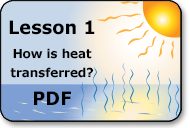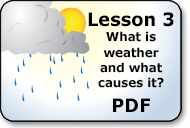How is heat transferred?
|
Students observe a demonstration of the role of thermal conductivity in heat transfer, and conduct an experiment to compare the thermal conductivity of four substances. (NOTE: This lesson may require two class periods.)
Download PDF
On successful completion of all units in Theme 1 (Changing Weather & Climate), students will be able to answer the following question with detail and specific examples appropriate to their age group: How are weather and climate changing in our area? |
 |
|
|
| Download PDF |
|
|
|
|
|
|
Next »
How are local temperatures changing?
|
In this lesson, students investigate temperature variability in several locations within a small, local area. Students interview an elder or culture bearer to learn how climate change is affecting normal temperatures in their region.
NOTE: This is a two-day lesson. Download PDF
On successful completion of all units in Theme 1 (Changing Weather & Climate), students will be able to answer the following question with detail and specific examples appropriate to their age group: How are weather and climate changing in our area? |
|
|
|
| Download PDF |
|
|
|
|
|
|
Next »« Prev
What is weather and what causes it?
|
In this lesson, students will learn what weather is and how the sun’s energy affects global weather patterns.
Download PDF
On successful completion of all units in Theme 1 (Changing Weather & Climate), students will be able to answer the following question with detail and specific examples appropriate to their age group: How are weather and climate changing in our area? |
 |
|
|
| Download PDF |
|
|
|
|
|
|
Next »« Prev
What is the water cycle?
|
In this lesson, students investigate the processes that make up the water cycle: evaporation, condensation, and precipitation.
Download PDF
On successful completion of all units in Theme 1 (Changing Weather & Climate), students will be able to answer the following question with detail and specific examples appropriate to their age group: How are weather and climate changing in our area? |
|
|
|
| Download PDF |
|
|
|
|
|
|
Next »« Prev
How do we observe and measure weather?
|
In this two-part activity, students learn and practice traditional methods of weather observation, then build an anemometer and measure wind speed.
Download PDF
On successful completion of all units in Theme 1 (Changing Weather & Climate), students will be able to answer the following question with detail and specific examples appropriate to their age group: How are weather and climate changing in our area? |
|
|
|
| Download PDF |
|
|
|
|
|
|
Next »« Prev
How does Earth's orbit affect the seasons?
|
In this lesson, students learn how Earth’s tilt and its relation to the sun affect the seasons.
Download PDF
On successful completion of all units in Theme 1 (Changing Weather & Climate), students will be able to answer the following question with detail and specific examples appropriate to their age group: How are weather and climate changing in our area? |
|
|
|
| Download PDF |
|
|
|
|
|
|
Next »« Prev
What can you observe about seasons in your area?
|
In this lesson, students learn about seasons from a cultural perspective. An elder or culture bearer visits the classroom to discuss various seasonal activities and observations. Students then spend time observing their own activities during the various seasons of the year.
Download PDF
On successful completion of all units in Theme 1 (Changing Weather & Climate), students will be able to answer the following question with detail and specific examples appropriate to their age group: How are weather and climate changing in our area? |
|
|
|
| Download PDF |
|
|
|
|
|
|
« Prev
|